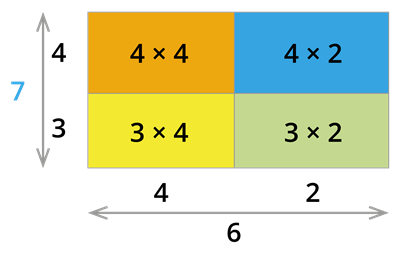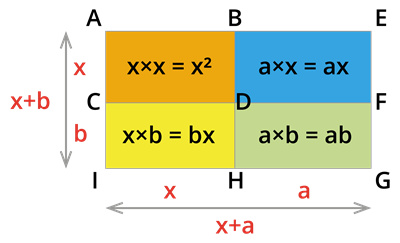UPSKILL MATH PLUS
Learn Mathematics through our AI based learning portal with the support of our Academic Experts!
Learn moreWhen it comes to solving the algebraic equation, identities play a vital role to solve them. In this lesson, we are going to explore the geometrical proof of identities.
Let us first see the varies identities which we will discuss here:
1.
2. (a + b^2) = a^2 + 2ab + b^2
3. (a - b^2) = a^2 - 2ab + b^2
4.
Let us take each identity one by one and discuss the proof of that identity.

By observing the above rectangle, we can notice that:
\text{Area of the bigger rectangle} = \text{Area of a square (Orange)} + \text{Area of three rectangles}
(4 + 3) (4 + 2) = (4 × 4) + (4 × 2) + (3 × 4) + (3 × 2)
Now, we simplify the LHS and RHS of the above expression.
LHS = (4 + 3) (4 + 2) = 7×6 = 42
RHS = (4 × 4) + (4 × 2) + (3 × 4) + (3 × 2)
RHS = 16+8+12+6 = 42
Therefore, LHS = RHS
Similarly, if we use the variables in this case instead of number we get:

Let one side of a rectangle be (x +a), and the other side be (x + b) units.
Then, \text{the total area of the rectangle }AEGI = \text{length } \times \text{breadth} = (x+a)(x+b)………….(1)
\text{The area of the rectangle }AEGI = \text{The area of the square }ABCD + \text{The area of the rectangle }BEFD + \text{The area of the rectangle }DFGH + \text{The area of the rectangle }CDHI.
\text{The area of the rectangle AEGI} =
……………..(2)
From the equation, (3) and (4) we get .
Therefore, is a identity.
Example:
Simplify the expression using the identity .
The expression is .
The expression is .
Now write the given expression with respect to the given identity (x+a)(x+b) = x^2+(a+b)x+ab.
Now simplify the expression.
.
Therefore, = .